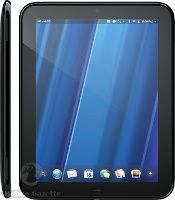December 11 will be a good day for early adopters in the US, as the very last batch of HP TouchPads will go on sale for the knock-down, drag-out price of $99—an 80% discount. It’s safe to say the last batch of the webOS-based tablets will be snapped up by early adopters as a hacking project and casual users looking for a low-cost alternative to the iPad 2. Both will be well served.
A bizarre statement from HP read "we are pleased by the response to webOS and look forward to customer feedback so we can further enhance the platform". Hardly the words of a company looking offload the last of its inventory.
Things get a bit clearer in relation to the European market: "In EMEA we are discontinuing the webOS hardware operations and will not offer any additional products beyond what might be currently available in selective [sic] outlets." So yes, it’s gone.
Biggest loser
Despite this being the last release for the TouchPad, it’s hard to call it a failure on any level given its poor treatment by HP. Thanks to the fire sale, the TouchPad is the second biggest selling tablet in the US this year and the reception from early adopters. That’s not bad for a device that was only on the market proper for six weeks. Yes it was all about the price drop, but a far-sighted approach could have placed the TouchPad in a similar position to the Amazon Kindle Fire: create a cheap device (or decide to make a loss on a reasonable one) and make money on app and content deals.
If the TouchPad is to be considered a failure it won’t be because of poor hardware or a buggy operating system, although both had plenty of room for improvement. The failure of the TouchPad is rooted in a failed corporate strategy going back to the $1.2 billion acquisition of Palm last year.
Having failed to position the Pre as a viable iPhone killer Palm made itself a prime acquisition target, and with Android yet to establish market dominance the time was right to provide a third way. For HP the acquisition made sense as it gave the company demesne over webOS—something they could manage as well as Apple does iOS or Microsoft does Windows, while making it as developer-friendly as Android.
New model for old business
With the hardware expertise, and in webOS a decent mobile platform to compete in the tablet space, why give up on the TouchPad after eight weeks (worse even than Microsoft’s Kin ‘social phone’ that sold only 503 units in two months)?
The sad answer is the TouchPad was the first victim of a boardroom tussle about HP’s future. At the time now deposed CEO Leo Apotheker mooted plans to take the company away from personal devices towards a service model, like that employed by IBM. Given HP’s dominance in the PC and printing space, what better way to send out a signal that devices were under review without damaging the core business than to start cutting off less well-established products. This put mobile first on the block.
A few months on, and Apotheker has been ousted and the future of the Personal Systems Group (PSG) has been secured, but even if the TouchPad proper was to be resurrected its time has already passed. Much of the excitement about the original fire sale was what happened after, how people hacked the OS to run Android apps or even run Linux. It became a toy, a testing ground, even an ironic status symbol.
One can imagine how many executives in the group must be looking at the last round of TouchPads leaving the warehouses and wonder ‘what if’?








Subscribers 0
Fans 0
Followers 0
Followers